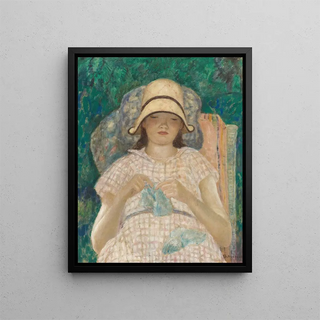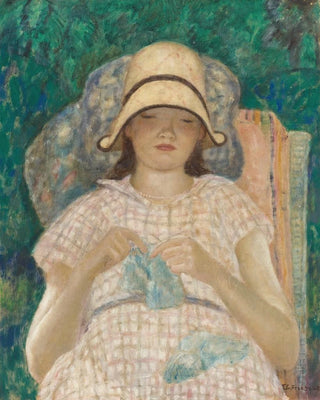Art print | Girl knitting - Frederick Carl Frieseke


View from behind

Frame (optional)
In the fascinating world of art, certain works stand out for their ability to capture moments of life, evoke deep emotions, and transport the viewer into a world of beauty and serenity. "Fille qui tricote" by Frederick Carl Frieseke is one of those creations that, through its simplicity and elegance, manages to touch the hearts of those who contemplate it. This painting, depicting a young girl absorbed in her knitting activity, invites a contemplative pause, a moment of tenderness and tranquility. The artist, through this piece, succeeds in immortalizing an intimate scene, imbued with delicacy and charm, making each glance an invitation to daydream.
Style and uniqueness of the work
Frederick Carl Frieseke's style is characterized by an impressionist approach, where light and color play a leading role. In "Fille qui tricote," pastel shades intertwine harmoniously, creating a soothing atmosphere. The mastery of light is particularly striking; it envelops the young girl with a gentle aura, emphasizing her focused expression. The details, though present, are not overwhelming; they serve more to enrich the composition without compromising its lightness. The texture of the clothing, the movement of the hair, and the delicacy of the young girl's hands are rendered with precision that reflects the artist's skill. This work is a true ode to femininity, creativity, and the simplicity of everyday pleasures, where each brushstroke seems to breathe life.
The artist and his influence
Frederick Carl Frieseke, an American painter of the late 19th and early 20th centuries, established himself as an emblematic figure of Impressionism. Raised in an artistic environment, he was influenced by European masters, notably through his stays in France. This immersion in French art enriched his style, allowing him to incorporate elements of light and color that are uniquely his own. Frieseke was also a pioneer in depicting daily life and women, often portrayed in moments of contemplation or creativity. His work,

Matte finish

View from behind

Frame (optional)
In the fascinating world of art, certain works stand out for their ability to capture moments of life, evoke deep emotions, and transport the viewer into a world of beauty and serenity. "Fille qui tricote" by Frederick Carl Frieseke is one of those creations that, through its simplicity and elegance, manages to touch the hearts of those who contemplate it. This painting, depicting a young girl absorbed in her knitting activity, invites a contemplative pause, a moment of tenderness and tranquility. The artist, through this piece, succeeds in immortalizing an intimate scene, imbued with delicacy and charm, making each glance an invitation to daydream.
Style and uniqueness of the work
Frederick Carl Frieseke's style is characterized by an impressionist approach, where light and color play a leading role. In "Fille qui tricote," pastel shades intertwine harmoniously, creating a soothing atmosphere. The mastery of light is particularly striking; it envelops the young girl with a gentle aura, emphasizing her focused expression. The details, though present, are not overwhelming; they serve more to enrich the composition without compromising its lightness. The texture of the clothing, the movement of the hair, and the delicacy of the young girl's hands are rendered with precision that reflects the artist's skill. This work is a true ode to femininity, creativity, and the simplicity of everyday pleasures, where each brushstroke seems to breathe life.
The artist and his influence
Frederick Carl Frieseke, an American painter of the late 19th and early 20th centuries, established himself as an emblematic figure of Impressionism. Raised in an artistic environment, he was influenced by European masters, notably through his stays in France. This immersion in French art enriched his style, allowing him to incorporate elements of light and color that are uniquely his own. Frieseke was also a pioneer in depicting daily life and women, often portrayed in moments of contemplation or creativity. His work,






